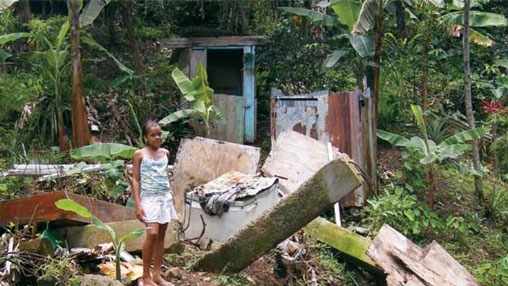Challenge
An important issue confronting Saint Lucia’s development is the vulnerability of its population and economy to adverse natural events. The island is exposed to a number of natural hazards, such as heavy rainfall, tropical storms, hurricanes, winds and droughts.
Disasters caused by these weather-related hazards impose large costs on the country’s fragile economy and exacerbate poverty levels. They have destroyed infrastructure and disrupted the provision of essential services. They have also absorbed a growing share of the national budget to cover recovery and reconstruction efforts. Up until the late 1990s, the conventional approach to adverse natural events in Saint Lucia has been primarily response and recovery post-disaster, with very limited focus on disaster preparedness, risk mitigation, or prevention. This reactive approach to disasters in Saint Lucia was the result of weak institutional framework and lack of capacity in the area of disaster risk management.
Solutions
Following the extensive damage caused by Tropical Storm Debbi, in 1997 the first World Bank Emergency Recovery and Disaster Management Project (ERDMP) financed primarily post-disaster reconstruction and rehabilitation. It also financed some physical mitigation and prevention investments and disaster response capacity building activities.
Building on the lessons learned and successful achievements of ERDMP, DMP II was prepared as a follow on operation to scale up disaster risk reduction interventions. Following the multi-sectoral approach of ERDMP, clear benefits could be derived from improving the country’s disaster preparedness and response capacities and its prevention-oriented physical investments, institutional strengthening, and capacity building activities.
DMP II was also aligned with the National Hazard Mitigation Policy which was under preparation at the time of project appraisal in 2003 and which highlighted the need to emphasize long-term disaster prevention measures that would embrace all relevant economic and social sectors (public and private) and facilitate the more effective use of scarce financial resources in a comprehensive approach to disaster management.
Results
Saint Lucia’s vulnerability to adverse natural events was successfully reduced, through the following improvements:
- Infrastructure improvements against the impact of adverse natural events, including the retrofitting of three health centers and four schools, rehabilitation of two bridges, coastal protection works, and small mitigation works in various communities across the island. These improvements proved to be effective, according to an assessment taken after Hurricane Tomas in 2010. They significantly increased the percentage of population with access to improved infrastructure, from 30 percent in the pre-project phase to an estimated 80 percent by project completion.
- The completion of the central Emergency Operation Center, construction of 11 satellite warehouses, purchase of specialized emergency communication equipment, and the provision of technical assistance and training in areas of disaster preparedness and response improved preparedness, and response capacity.
- Strengthened capacities of various ministries and agencies dealing with disaster management through technical assistance and training, improved enforcement of territorial planning and building code regulations, flood risk assessments in Dennery and Soufriere, and landslide risk assessments in seven communities. Drought hazard maps informed land use planning and physical development policies and decision-making.
